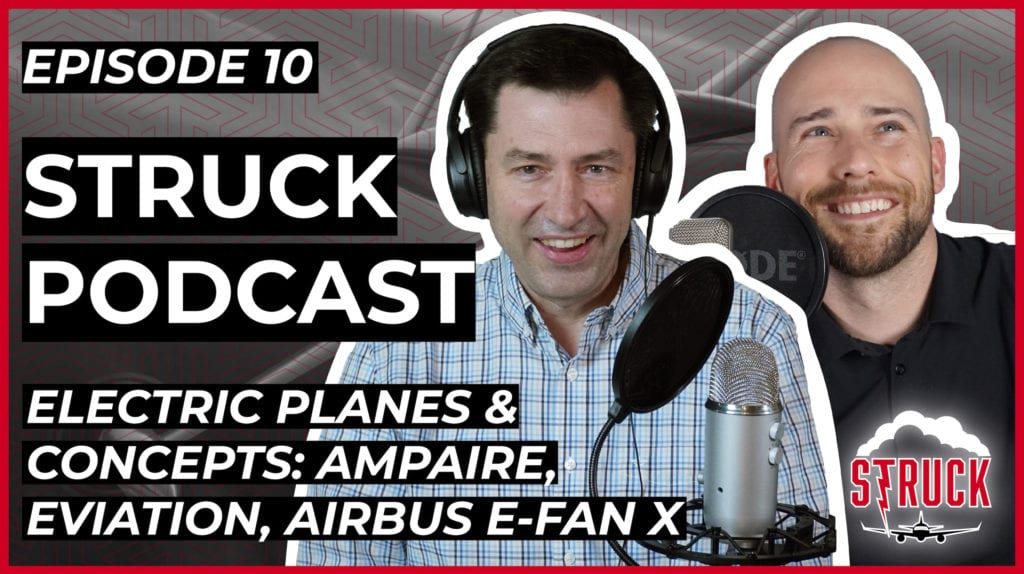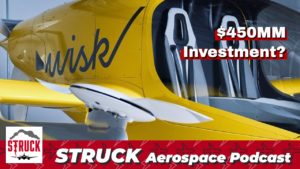There are more and more electric plane companies popping up, many of them trying to take over the short trip market. Air taxis and planes serving small airstrips and airports can potentially be big business…if these aircraft can get certified. We discuss electric aviation challenges and the difficulty of certifying a new aircraft from the ground up.
Learn more about Weather Guard Lightning Tech’s StrikeTape lightning protection systems here: https://weatherguardaero.com/striketape
Podcast: Play in new window | Download
Struck Podcast EP10 Full Transcript – All About Electric Aircraft, Eviation, Ampaire and Airbus E-Fan X
Watch the video version here on YouTube: https://youtu.be/MnTSui6FYbQ
All right.
Welcome back. This is struck episode 10 Allen, how are you doing?
Hey, Dan. Good. How are, how’s Washington DC doing? Uh,
we’re, we’re hanging in there starting to get nice 80 82 degrees, I think today. Partly sunny, 85 yesterday. Hm. Interesting. Interesting. Just a sudden jump into summer weather, so it was nice.
Yeah. Well that’s cool. Yeah.
So baseball,
no, nothing. There’s no nothing, but the national mall is very green. When I go down there today. Mmm. I guess the center cut portion of the, of, of the mall, which I, that’s such a weird saying. Mall always sounds strange to me because you just, who doesn’t associate the word mall with a little like a shopping mall?
Like going in and out of forever 21, they’re like, you don’t know? No, that’s where I shop. But you know, my little sister, um, it’s a park.
It’s a park.
Yeah. Like the term is, it’s strange. It’s just like. Anyway, I digress. But nah, the grass, just like all the wildlife, like are people that talk about wildlife coming back with the crowbar by herself.
The grass has just superb, super green dense. Cause people aren’t on it. They kind of like kept us off and there’s not that many people in general. So yeah. Um, the parks here in DC or live and well, so, so yeah.
Well, did you see that video yesterday? I think it was yesterday. Uh, I’m just thinking, cause no one’s out on the streets right now.
You see that tiger walking down the street of that town of Mexico and the guy’s trying to last through the tiger down the street. Do you see that?
That seems like a fool’s errand to trying to catch a tiger. That’s a good way to get eaten by that tiger. You just gotta let that tiger go to an extent. You got a tranquilizer, dart it and call it.
Call it a day.
They last through this tiger and the street. Unbelievable. Like what’s their tiger in the street? Is that somebody’s pet that just got out? It’s kind of like Florida with the pythons, right? Like people let off their pythons and then they try to go out in the wild and they’re 50 feet long and they’re,
yeah, I remember seeing this video and it was somewhere in like me, like India or you know, where like Jaguars and like cheetahs are like, and again, I don’t know if this exactly works.
I don’t know if cheetahs are in India, but. There was like one of these big cats, so it wasn’t a tiger, obviously it was like a Jaguar cheetah, like one is a medium size, big cats, but it was like in this little town and it was just like running around like tackles a dude. Then everyone’s like chasing it, chasing it around, and it was kind of terrifying how fast the scared.
You know, like five foot long, whatever it was. I think it was, I think it was like a Jaguar, but yeah, it’s just, it was just this cat was like trying to get out. Everyone was like trying to shoot out of the little village. It was like jumping up this wall, this building and this building and just like, it was scary because if you’re anywhere around.
This cat is like, Oh, I’m going to go punch you in the face, or I’m going to bite you real fast. I’m gonna try to go this way and go that way. I mean, the agility, the agility of these wild animals, it’s just impressive. Remarkable, isn’t it? Yeah. But yeah, that’s why I’m not trying to, that, that tiger, that Jaguars walking
down the street.
Just go at your own pace, sir. I’m not going
to bother the fight, right.
Don’t mind your day. Yeah, we’re good. We have murdered Asian giant Hornets now too. Like, no thanks. Goodbye, sir. No,
well, here. You know, the bears have finally woken up from their winter slumber and they’re looking for food, right? So the next town over, they had a, uh.
Bear ended up in a car and then not even sure how I got in there, but
it got, wow, is it nighttime?
You hear the car shaken outside like what the heck’s going on? And as the news reported, it is like looked outside the card, shaken, realized that there’s a bear in the car and the bear can’t get out. So what are you gonna do with this bear?
Well, in the meantime, the bears all upset, so he just starts eating everything in the car seats. Steering wheel console just starts ripping apart the car. Uh, so they, they brought up another car next to this car and then they pop the door open and the bear shoots out. But at that point. Cars totaled?
No, for sure.
Total they car now. So that reminds us here that when you go grocery shopping, that uh, probably the thing to do is always close your doors. You come in, in and out and make sure, like you’re kids aren’t still in the car with the groceries, the doors open because you never know. Right now bears have the rate or just all the
weird thing to have to think about.
I gotta. Oh yeah. It’s a weird thing that, wow, that’s crazy. I never thought about that. Yeah. Which makes sense. And I’m sure in a lot of places in the country that is a thought that people have had. Like if you live near Yosemite or something, or you just live in a heavily forested woods, that is a thing, I’m sure.
Yeah. If you have bears in the area, food outside in your car makes sense. Pad. But I’ve never had to think about that. Yeah. Yeah.
No. Like our trash cans are on our garage. The reason you put trash cans in the garage, because if you don’t, then you’ll have a bear in your backyard. So you always put your trash cans in your, in your garage just to keep the bears away.
Yeah.
Interesting. Yeah. Life in the wilderness. Yeah. Well, speaking of keeping things in doors, a news report in Singapore, a FedEx pilot was arrested for. And he was sentenced to four weeks in prison after leaving his hotel room for three hours to buy masks and thermometer.
Yeah.
What do you, what are you nuts from Alaska,
right?
I mean, the guy, the guy’s a pilot. He’s not some buddy that’s, you know, trying to cause trouble. All he’s trying to do is probably moving medical supplies from one country to another. That’s probably what a lot of these flights were about. Moving essentials around. And then you. Arrests, his pilot. I get the whole thing where obviously he broke a law.
He probably didn’t even know it existed. Maybe you knew it existed. Uh, but is that the person you want off the street be like a rest and a doctor? My opinion is that the person went off the street right now. No, no, you don’t. And what harm really came about it? You want to find them. You want to. You know, make FedEx pay a thousand dollar fine, but putting this guy out of commission, that’s to me is a little overkill.
I’m not sure we would
do
that. He sounds like a real monster. Leaving his hotel room for three hours implies
that professional pilot, you know, probably spent most of his life learning how to fly and airplanes. Yeah, no, this is the wrong guy. Behind.
Well don’t, it doesn’t say in this article what the law is like.
You just can’t leave for any reason. Cause that seems like a valid reason. Like he’s got like, he’s got a hall pass, like, Hey, like teacher said, I can go to the bathroom. Like that’s crazy. Like what is the rule doesn’t say that here. I don’t know
it, you can’t, you can’t drink there either. Right? There’s no bars there.
So I don’t know. Yeah.
Yeah. They’re just trying to make everyone angry.
Well, I don’t think that’s a place where a lot of, uh, you know, if the pilot’s out and he’s out, I dunno. Playing craps in the back alley or something. I’m like, okay,
all alright, cool. I don’t play dice in the back alley. No. Cockfighting no, no, no.
Got healthier, right? Yeah.
But you know, this, this guy. Ah, you gotta think FedEx is going out of their mind right now about us and trying to work the government, try to deal with the police, and then trying to get their pilot back because now I got to spool up somebody else to fly this route. Golly, come on.
Yeah, that’s a shame in other, uh, it, well, in business news, uh, so phaser, uh, has filed for bankruptcy. So tell me a little bit about phaser. I mean, you, you know them quite
well. Yeah. Phaser was or is probably still, cause I think they’re are bankruptcy to restructure, but they went through bankruptcy before.
They make an electronic, uh, electronically steerable antenna that’s made for Satcom use. And they were trying to get into the aircraft market because their system would be more aerodynamic. Uh, possibly way less, uh, maybe have slightly better performance than the mechanically steered antennas that we use for satcoms right now.
Uh, and, but, you know, there’s, there’s a lot of difficulties with those systems mostly having to do with heat generation, because if they’re electronically steered, which music is lot of power, which means they get warm, or in some cases they get hot, and then you got to deal with all this heat and heat and stuff.
So, uh. I, I, you know, there was always been a case for electronically steered antennas and phaser had a very viable product. It was a matter of just a timing. The timing was bad. When they’re in the midst of development, they’re spending a lot of cash and now there’s a lot of airplanes off the market.
They’re not sitting in sitting in fields waiting for the airline industry to come back. And it’s probably just a matter of timing. I don’t think electronically sturdy antennas are going to go away and phase her. We’ll probably be back in the, obviously the engineers are pretty smart because it designed a Santana that’s not easy to do, right?
You just don’t wish things like this to happen.
Yeah. So tell me a little more about electronically steered antennas. Like are other companies making those? Like does think calm, make those, cause we talked with them on the previous episode, like is that how current is that? Is like the cutting edge of technology right now?
Or, or what is that? As far as like satcoms.
Uh, Oh, it’s been known for a long time. You, you basically take what we’ve been, we’ve had electronically steered antennas on a lot of things, uh, for a very long time. The, the, Nope. Some of the most interesting ones I think were on ships. Uh, but the, on the aircraft side, mostly military aircraft, we use steerable antennas and what they are are just, uh, an array of antennas and how you phase them relative.
So you’ve got all. It looks like a 16 by 16 grid of antennas, and then you phase them differently so that it effectively steers the beam without you mechanically moving it. Hmm. It, it works. Obviously it’s just electromagnetics. Right. And then a bunch of electronics to control it. Then come already does that now think comms a combination?
It has electronically steered and it’s mechanically steered, so they got the pie plate design, the pizza plate design where it spins, but it also can steer kind of up down electronically.
I like that you’re very specific that it wasn’t a pie. It was more of a pizza. That’s a very much our listenership here.
Guys, I liked gals listening. This is not a pie plate. It’s a pizza plate thing. Alright,
well it has to do with relative size, right? So I’m trying to put it in perspective and things is New York
style pizza is a Chicago deep dish. Is this Giordano’s pizza? I mean, this is serious stuff here.
Well, okay, so it’s much more like a Chicago deep dish.
Pizza. I wouldn’t say cause it’s sick. It’s sick. It’s probably an inch and a half to two inches thick. So it’s not, it’s not thin. It’s not a thin crust, New York style. It’s more like a thick crust pizza.
I love that you’re indulging this nonsensical. I’ve
been in Chicago.
Yeah.
Engineer’s gotta eat. Right. Uh, so engineers, engineers travel a lot, typically, and we eat a lot of lead, a lot of restaurants.
So we have pretty much had every kind of food in the world, particularly in the States. I’ve eaten everywhere. So I’ve eaten at all those pizza places in Chicago. So it’s much more like that. What’s a deep
dish pizza thing,
and it spins, right? So it’s like a large, deepest pizza.
Okay. Pizza, pizza expert.
Allen hall discusses that comm. Yeah. Well, it’s just like that
now. The phaser thing was different. It’s kind of like Kymeta come at as in the students similar things was just basically a flat peace and, uh, space X is doing something similar. There’s a lot of people doing similar things, but it’s, it’s a, it’s a flat plate.
And it doesn’t move. There’s no mechanical moving parts, so it’s all steered now. Right. Issues on airplanes, uh, are that airplanes are never really stable. And obviously you fly on an airplane, it gets bumpy. You’re trying to track the spacecraft that, uh, and geosynchronous orbit. And I think that’s a, I forget how far that is, the waste and always working in industry.
It’s a long ways away. So you’re trying to focus on this one pinpoint in the sky and the airplane’s bouncing around all the time. It’s hard to do that. Electronically. It’s hard to do it mechanically. Uh, so it’s a complex thing. It takes a lot of power and they’re not electronic. Extruded antennas require more power to look to the side, then a mechanical and a mechanical.
You just turn it. I look. And on electronic actually have to do a lot more work to get a lot more power to do that same sort of thing. So that, and the problem with electronic, sturdy antennas is okay, generate a lot of heat. And if you’re on the ground and say to you in Saudi Arabia or someplace that’s really hot and you got, you’re running a lot of data through it, it’s going to get warm.
You gotta gotta do something to deal with that heat. Gotcha.
Gotcha. So we’re gonna transition. We’re going to talk a bunch today about electric aircraft. And, uh, and this is an interesting topic because there’s a lot of new small companies that are trying their hand at this. Um. So the first one, this one is a concept.
It’s really, honestly kind of bizarre looking, and this is, it’s zero by Joe Doucette, who, if you look there, Joe does sets portfolio of stuff. He’s designed to think he’s crazy, incredible designer. Um, and this is just a concept plane. And he’s not a here, he’s not an aerospace engineer, but Nope. This, um, what, what do you got on the zero?
The zero plane concept looks, it looks, it looks strange.
Yeah, airplanes have a couple of restraints, like swore the center of gravity Israel to the center of lift, and that’s what we call stall. If you get in the wrong condition, it won’t fly. Right. Uh. That airplane looks like it has a really weird center of gravity.
Yeah. Cause like most of it is forward and the wings are very far shifted towards the back, which yeah. The first year. Like, cause this was like a pencil. It’s like a flying pencil.
Well, ever been on an airplane where they’ve asked you to change seats because of weight and balance? Yeah. We were in a smaller place.
I haven’t, no.
No. Okay, well maybe. Maybe I’m heavier looking,
so maybe, maybe one day I’ll be in, I’ll get asked to move. Maybe one day,
excuse me, sir. We need a wait and bouncy airplane. Can you move up to the front of the airplane for weight and balance? Like, okay, why are you picking up me? Uh, but that the weight and balance is as how the Keith airplane stable, whether you distribute the weight on the airplane does matter, right?
If you get the weight too far back or too far forward, it
doesn’t fly right. Well, that was the why that one aircraft was at a seven 47 the crashed. I feel like it’s an Iranian seven 47 I saw this videos. It’s terrifying. And there’s this, they caught it on video where it’s going up and it just flutters and then just smashes into the ground and the whole thing as a Iranian military, I think a cargo aircraft.
And they said, Hmm. And I could be getting some of the details wrong cause this wasn’t in our, like our, our layout, our plan for today. But. This video videos. It’s terrifying because that was a real plane with like real, it looks fake, like it’s so crazy. But they said that they thought it was, it was carrying a lot of cargo and that it probably shifted, like maybe a strap broke, like maybe a strap broke and a big piece of cargo shifted.
And that’s probably what happened.
Wait mounds,
right? You
get the center of gravity off and then all of a sudden all hell breaks loose. You can’t do that. Right. And that’s the same sort of thing. If you have cargo break loose in an airplane, uh, it’s a big
deal. Yeah.
Right. So the, this airplane that Joe’s designed, to me, it looks like it’s not air worthy for this story.
And it kind of relates back to an earlier conversation we had about what are we doing with our practice on him right
now? Yeah. And that’s, I think, a fair question for anyone because you start to look at these, and this was the same thing with electric cars. You’re like, Hey. Okay, there’s an electric car.
Why does it have to be so ugly? Hey, look. Oh, another electric car. Why does it look like that? Why can’t it look like a normal car? Okay, so it’s electric, but does that mean it has to look like a flying like clownfish or driving cloud? Like it’s like the Honda Prius or the Toyota Prius is still just awful looking.
It has, and it’s designed, has nothing to do with the fact that it’s electric. It’s just like, we chose that.
Well, okay. Okay. Having haven’t built an electric car at one point in college, uh, aerodynamics are huge in terms of energy usage. So you’re trying to build a slippery. Aerodynamic, lowest rolling resistance, then you can design.
Right. That’s where the tires are there. Yeah.
Which doesn’t seem to be, that makes sense for the new cyber truck. For Tesla. Right. That seems to fly in the face of that driving trapezoid of ugly ugliness.
You know, it’s ugly and it’s going to sell a million of them.
Yeah. Well, not to me. I would never. Drive that behemoth.
But anyway, so, so why, why are aircraft designers of these electric aircraft trying to go out of their way to make them so different? Is this just like we’re trying to look cool or is this actually an important aspect of a, what do you have on that?
Well, if you think about the number of aircraft over the years that have been cool looking and then also never gone anywhere.
I, I’ve lost track on all those airplanes. Burt Rutan was a big designer way back in the seventies and eighties. Uh, the beach star ship was a Burt Rutan design. He had very interesting concepts for airplanes. Uh, they are playing that flew around the world nonstop. Uh, that was, uh, airplane. Uh, and that’s in the, that’s in the mall.
They’re at, they’re in space museum actually. Okay. So these unique, unique. Shaped airplanes have very specific, it should be designed for very specific purposes, like if it’s a heavy lift aircraft or it’s got a glide along way, totally fine. I’m okay with all that, but when you get to something that’s just a commercial aircraft to carry people from point a to point B, and what are we doing right?
If you’ve got some. Genius, breakthrough and aerodynamics, great. Let’s get it on the table and let’s hear about it. But otherwise, what the heck are we doing? Making, making the process to certify an airplane even more difficult than it is already. Anytime you introduce a new or novel feature. And you’re trying to certify it with a FAA Yassa I don’t care.
Pick picking him was transport Canada. Pick any of them. You’re going to have trouble because they have to figure out what the rules are for that different flight characteristic or flight regime or or, or performance. Right. So why do you do that? If you want to make an electric airplane, then make an electric airplane.
It can have a wing. It can have. And panache. It can have a fuselage. It can have landing gear. Simplify the thing, because the technology is trying to promote is the electric motor battery concept. That’s what you’re trying to promote. That’s why the flier and George bye makes a ton of sense because he’s building an airplane.
He’s built on an airplane that’s run with electricity genius, right? Don’t, don’t try to rechange the world because you’re, in this particular case, this is why. This is why Elon Musk does not design airplanes. Elon Musk doesn’t sign airplanes because there’s a regulatory body that puts a lot of requirements on you that that force you down a certain design path.
And. When you have an airplane, you have lawsuits. So in a car, the worst, just get realistic about this in a car, if you have a car accident, most likely people aren’t going to die. If they do, it’s going to limit a number of limited subset and an airplane. Any sort of moderate to significant crashes and converge dozens to hundreds of people.
So. Therefore, you have all these different regulatory requirements and the Jeff Bezos and the Elon mugs and all these guys that design it, all this stuff don’t get into airplanes because there’s a huge downside risk to do it, and yet we get a lot of the small, smaller players, I’ll call it, that try to redesign airplanes to do all these things, which we don’t really need, right?
We just need to be more efficient about the way we travel, which get that, or we need to be safer. And the way we travel. Let’s do those things first. We can figure out how to, to create new aerodynamics on the fighter aircraft. I just don’t, I get it. Because what you don’t want to do in an aircraft is fail on a new aircraft program.
You got enough expenditures. Why do you keep adding on problems? I don’t, I don’t get it.
Yeah. And that’s something that I hadn’t thought about before cause they were talking about as I was doing a lot of research here with like an pear. They have a retrofitted electric plane. And that compared to say, the aviation Alice, which is a brand new, you know, built from the ground up.
Quirky, kind of strange looking, small commuter plane that they project will be, uh, $4 million, um, and cost and $200 an hour. Tom rate, which is, which is great. Mmm. But that’s from the ground up. So they’re talking about this is going to be a two to three year process to certify the the Alice versus a plane where they’re just taking an existing certified plane and retrofitting the engine with a electric engine.
Yeah. I mean, how, how much, how much time is that going to save them and headaches on the certification process, retrofitting versus ground up. It’ll
probably save them a billion dollars.
Is that good?
And I’m dead serious about that. It’ll probably saving a billion dollars to make an airplane that carries nine, 10 people isn’t cheap.
It’s several hundred million dollar effort, uh, to retrofit and all Cessna sky master costs. $50,000 a hundred thousand dollars and you’re proving the same point. You’re trying to prove the point that you can do an electric aircraft. And if you use an existing airframe that has been proven over time, like the sky master was developed during the late 1960s early 1970s we all, we know how it performs.
So putting electric motor, I’m taking out one gas motor and putting an electric motor, you still have the remaining gas motor. Makes infinite sense. Mmm. The Alice thing, where they got the engines out on the wingtips. Have we ever, have we ever certified one, something like that? Nope. Nope. Uh, as far as I remember, we haven’t, so you’ve got all these loading issues.
You got these torquey shoes on the wing, you’ve got, uh, propellers out in the, yeah, no, right. So it looks cool and an air show, and I’m not saying it’s not a good concept. I, it may all be there, but. In order to get to central to production thing, you have to take it in stages. And um, this has been the Cessna approach for a long time, has been the Beech aircraft approach for a long time.
And those are the aircraft companies that are survived. The other ones have all gone away. Even Cirrus has done this very, very wisely over time. Start with a basic fundamental aircraft. And then keep working it and working it. Like Cirrus has a new, a new jet right now. It’s just an outgrowth of their propeller driven airplanes, diamond aircraft’s on something very similar.
They started with a very basic fundamental design and improve it over time. We need to get back to that point again. Uh, even with the new regulation change in part 23, where they’ve taken a lot of the restrictive rules out to open up the doors, it doesn’t mean that the amount of design effort is going to change all that much.
It’s still going to be on a bunch of money. And so you try to minimize the cash burn and for some reason, um, well you haven’t figured that one out. It’s troubling because that’s an industry I love and I, I participate in all the time. And you just wish they could think about this a little bit differently.
Well, you wonder if there’s some. Design aspects that that require maybe a whole new ground-up design, like trying to stuff in as many batteries as they can, like stuff like that. Building them into the frame, like the way Tesla’s batteries, other cars is kind of integrated into the frame of the car. Okay.
I don’t know the specifics. That could be part of it. I’m not sure. But there could be. What do you think of the, Oh, the other cost savings. So it says like for the ALIS, for example, they estimate $200 per hour to operate a plane. I mean, how does that compare with. With a, a regular small 12 person commuter
Angelo seems, seems like a fraction of what it should be.
Like five, five, five times lower, if not more.
Yeah, I was going to say a thousand bucks an hour.
I’m like, that would be
typical for those kinds of things. I remember, uh, when I worked at beach and we. Okay. You had to rent the airplane when you worked at Beech aircraft to go somewhere. So you had to pay for pilots, you had to pay for the fuel as part of your program expense.
So if you had a bunch of engineers that needed to get to salt Lake city, for example, it was less expensive to load up an airplane. You’d have to pay for it. You had to get the pay, the pay the company back to load the airplane instead of buying airline tickets. So it didn’t make sense. But the, I remember pricing that out in the thousand bucks an hour.
Um, I think a King air was like 500 an hour. A beach jet or some sort of Joe’s is a thousand bucks an hour. So the faster you go, the more expensive it is, but the less time it takes. So it roughly evens out. So in a King air, it takes longer to get there, but it’s less expensive per hour. Know that’s about the same.
Yes. But it to think that things are going to cut down the amount of, uh, costs per hour by a factor of five. Seems implausible. Not to say that they haven’t done their homework, but on the face of it seems really difficult to believe.
Yeah. And that might just be one of those, I mean, I think when a, you know, a piece of advice back with my first business that my cousin who’s in the financial sector gave me, he’s like, whatever, whatever you’re making, cause we were going through a sort of pivot and he said, whatever you’re predicting your expenses to be and whatever you’re predicting, he’s like, okay.
Over, you know, exaggerate your expenses by maybe 50% and reduce the income that you expect by maybe 30%. So he’s like really be. And so it could be just something like that where that’s maybe the pie in the sky answer. Um, and you’ll see when they get there to production, if that’s really that, I’m sure it is a significant reduction, but yeah, you’re right.
That’s a pretty big cut, so you’ll have to see, and that really plays out that way.
Right. There’s a lot of your, your financial advisor is right. There’s a lot of overhead you don’t think of when you haven’t been through it. There’s a lot of overhead.
Well, yeah, and you just, it’s easy to just throw things out on people.
Oh yeah, we’ll get this many good, this many customers. And you know, it’ll only be that many. You just always forget the unexpected expenses and the, the headaches and the time lost and all these things. And just. Things don’t go the way you think they’re going to go.
Yeah. If it would be, if it was easy, a lot of people would be doing it and if it was financially viable, there’d be a lot more people doing it.
And over time, from the 1960s to today, we’ve seen fewer and fewer and fewer aircraft companies. Yeah. It’s gotten more and more typical to do it. That’s why the part 23 regulations have changed in the last year or two to try to open that up, to make it less, uh, onerous to try to start aircraft company. I don’t know versi and fruit from that quite yet, just because of the Whoa thing that’s going on.
But. Know some of this has to play out. I am optimistic that we’re going to get back to the, what I consider sort of the heyday of some of the airplane business, which is sort of the early seventies late sixties when they’re pumping out dozens of airplanes a day. That would be great. Vague, get back to those numbers, but the overhead is so expensive.
It’s unbelievable.
Well, the way we could save everyone, we could do this. This could be, we’ll get it. Probably shouldn’t air this because this’ll be okay. I mean, this is a big idea, but we develop a vaccine or a cure that we can crop at us at a Plains airline industry comes back, everyone’s saved, and we’ll use electric airplanes.
So electric airplanes are just crop dusting the entire country in a Corona virus. Eradicating aerosol. It’s perfect. Solve everyone’s problems all at
once. I’ll get right on it. Right?
And then with our billions of dollars from this idea will then invest that in small businesses locally to save them too.
So you heard it here first. You heard it here first.
You got that all figured out, huh?
Yeah. Yup. Sounds good. So last one on the, on the list here. Um, the air fan or the Airbus . So. All right.
That’s when they stopped the program on recently, right? That’s the four engine thing that, yeah, and I think they took down their site.
I was trying to look for the site this week.
I got it. It’s still here? Yeah. Okay. So why did that, why did that fail? Let’s go on what I wanted to discuss. I mean, it looks like for monitor engines, but one of them was going to be, um, a two megawatt electric. So yeah. They just ran out of money. Huh?
I am assuming that everybody’s just trying to conserve funds, like Boeing sent a lot of that to all their plane companies have basically shut down all the R and D programs just to conserve cash.
It’s probably a short term thing. Hopefully they get it back up and running because a aircraft is a sort of a symbol. Last I saw of it, it was pretty much ready to go out and do some testing. And this is the way we test all new engines, by the way, is we put the new engine on an existing airframe and then go fly it around.
So like a, we’re out in Phoenix. Mmm. Not in the desert out there. And GE was touching their new GE. 90 engine G 90 X, I think of what I was in his honor, it hadn’t mattered to a seven 47. So it’s a four engine airplane. They’ve taken one of the engines off and put this engine on it. Let’s look awkward. But um, so that’s the way you check out new engine performance.
You attach it to another airplane that has multiple, excuse me, multiple engines, uh, because
how many, how many does it need to stay? I mean, how many engines can you lose before the plane goes down mean how many of those forests are essential? Yeah, I think
too. Two I think are essential for that airplane.
Uh, the engine is such a huge thrust generating engine. Um, I wonder how they deal with that. On the thrust side, it’s way more than the standard engine is on a seven 47. But you’ll see that like you can actually Google some of those things. You can actually see, uh, uh, engine testbed aircraft. It’s sort of interesting to watch because you’ve got these really funky shaped airplanes at sometimes, like, I think it was Honeywell who makes jet engines.
Also, I had attached an engine to the side of a fuselage, I think a sub of a seven 57 and they done a lot of testing with that. Yeah. Yeah. So it’s funky to see. But, um, any new engine development thing is big. Uh, you’re going to spend a ton of money. You got to go fly it. Obviously you got to do all these different kinds of tests.
So I think, and just in terms of Airbus is expense there. We’re just trying to minimize that. The flight test hours are so expensive. It just makes sense to kind of shut it down for a while, but I don’t think you’re gonna see the end of electric aircraft. It’s going to continue. Especially if the Tesla work actually happens and the and the battery costs come down, we’re going to have electric graft after at some point, especially at the sort of the kit level, the Homebrew level.
I know Oshkosh, Oshkosh, cautious not going to happen this year, which is the experimental aircraft associations fly in and Oshkosh, Wisconsin, and they, I’ve been to that when I was. Ooh, that’s probably back in the eighties last time when I was there, but there’s this a hundred
thousand do they have good, do they have good pizza there?
How was the pizza in
Oshkosh? Well, no, you’re in Wisconsin. Uh, you’re kinda up Northern Wisconsin now. A lot of cheese there. That’s
a lot of cheese there.
A lot, a lot of cheese there. And it was a lot of people. Oh my gosh. That’s a huge thing. And that’s where you see all the, uh, Homebrew kit airplanes show up and all the different varieties and all the unique.
Layouts and everybody is trying, something new happens that level. It’s very similar. I always look at it as Oshkosh used to be like, uh, uh, back in the late seventies, early eighties, the computer developers, all those little clubs used to have our people were developing computers. It was a, it’s the same sort of thing except on an aircraft level, and some of the newest technology actually comes out of places like Oshkosh.
Right. Thank you. Because you can try it out small, right. Just try it out small. So yeah, it works. And then you can make, make it bigger over time. Someone asked me that, someone asked me the day, um, uh, was asking about the seven 87 and all this great new technology and the seven 77, it’s a carbon fiber airplane, blah, blah, blah.
Yeah. But. Beach aircraft did it 20 years earlier, roughly, uh, with Starship. And before that there was a Lear fan and a lot of the people that worked on my program, my program, and when I worked at Beech aircraft were working on composite jets. All those, all those guys. Yeah. Engineers ended up in Seattle design on the seven 87 so realistically, you know, a lot of this stuff starts small and then percolates up to the big guys.
And now Airbus is building airplanes out of carbon fiber, like they’re building in Oshkosh 25 years ago, 30 years ago, 40 years ago. Start
small. Yeah. Well that makes sense. And that’s what they’re talking about. Most of these. Oh, these electric aircraft are good. It’s going to be a little kind of commuter planes, right?
Like under 500 miles, stuff like that. And potentially, I think this was the case mostly with, uh, aviation. They’re Alyse aircraft. They were hoping that that one could be sitting there kind of like puddle jumps to places where they don’t have a lot of, uh, air travel, like a lot of like, you know, Americans not flying there a bunch or whatever.
Just some smaller airstrips
yeah. That’s what my aerospace was doing because they were doing, they had a company that hooked up with, that’s going to be doing, uh, basically shuttle flights out of lax to some of the surrounding airports going, like flying up North to Sacramento, Oakland, those kind of things.
Whereas you can actually find lax on an international flight, and then instead of having to sit and wander around or try to drive back up to Sacramento or down South to San Diego, you just hop on this little leaf flower and go do it.
Yeah.
And then they were going to prove out electric aircraft. I mean, there you go.
There’s your perfect case starting
small, starting small, and then, you know, obviously that’s going to be the, uh, people that were, have the money to go do that. They’re going to start off, we’re going to figure a lot of things out. It’s similar to, uh, it’s so much like Garmin, it has done for years. So Garmin’s technology was always GPS.
So you and I probably know them originally as having a little handheld GPS. You put your car before. Cars had GPS, right? She used to buy these little handheld garments. What? Garmin has a whole aviation division that late the Kansas and they started developing avionics long time ago. Uh, G was probably before 2000 so yeah, they’ve been doing it a long time.
25 30 years, probably now. And if you watch them go, like they don’t develop airplanes, they just develop the avionics systems, the autopilots, all the flight controls. They do all the integration stuff, and like some of the products we’re putting out now are freaking fantastic. I think I’ve have touchscreens, right?
Uh, they’ve, they simplify the interface. They have that safe return flight system for, uh,
yeah.
Right. And it all at the same thing. I think for a Piper airplane, one of the Pipers has the same system. I like that. That’s a Garmin thing. Like they’ve just. Gradually added on, got smarter and smarter and improve, improve, improve, and like the new G three X, which is our smaller system for, I think that’s what a bio aerospace is using in their aircraft.
Wow, this is cool, right?
This is really cool stuff. But
they didn’t go from making GPS and handheld GPS to put in your car to then designing. Flight control systems for Boeing. They didn’t do that. They started out small and, and learned along the way and kept making it better and better and better. And now it’s, in my opinion, they are a very serious player and the avionics world, just because he has so much knowledge history, and they have the, now they have the infrastructure behind them to do something big or to make automated flight like pilotless aircraft.
So there’s no way that Garmin does know how to do that. They have to know how to do that. By now they have, I’m sure they haven’t, you know. Well, we get to the point where we can actually hop on an aircraft and you say, I want, I want to go from Williamstown, Massachusetts. I want to go visit Dan pink. I’m going to punch it in there.
And in a way I go, that’s going to be a company like Garmin is going to do that. It’s not going to be a company like me doing that. It’s gonna be a company like Carmen’s going to do that.
Yeah, that’s interesting. Uh, all that GPS technology, but it’s come such a far away. Yeah. You know, my brother in law who’s in the military was talking about how when he entered the military, like GPS wasn’t a thing like for soldiers and now, and then early on he was pushing for it and suddenly he can, everyone can, you know, a couple of years later, everyone can know where everyone else in there, there their platoon is, and they can coordinate these missions so much better because they now know.
Um, well they are videos and that was, that wasn’t a thing for so long. And now it’s just like everyday, like you can look on Snapchat and, and know where your friends are if they turn that setting on, which is creepy and strange. But yeah, I mean GPS and all this tech tech cause Garmin, you never, like you said, I never associated it with anything but in car GPS.
But it’s infiltrating every aspect of our lives and tracking us. It is helping us move, you know, travel around faster. So that’s
cool. Yeah, and one of the things I designed when I got it first got out of college I used to work for was GE, and then it became Martin Marietta that became, Lockheed Martin was a, I worked on the GPS block to our satellites.
So I was designing antennas that are probably still flying. Uh, honestly and okay. And I remember at that time, this is before my kids were born. Uh, so my kids don’t know anything but having GPS. But we were, this is some of the early generation of GPS satellites and what a huge advantage it was for the United States to have that system because you could tell where you were at any one time.
Right. Huge.
Yeah, absolutely. Speaking of, this’ll be kind of the last thing we touch on, but GE is in trouble. Have you listened to much of the business stock news recently?
Yeah. I don’t own a GE stock. I used to own a whole bunch of GE stock and I got out of it to, Oh, before the, before 2001, probably 2000.
I got out of it. Um, cause we worked there and we used to be part of our incentive plans end up with all this GE stock. GE has really struggled, um, mostly because of their. They were in the insurance business for a long time and they had a GE capital, so there had a lot of investments and the insurance and the insurance business, they try to offload the insurance business, uh, and they couldn’t cause don’t want, wanted to take on that risk, particularly of insurance of, of older people.
And so they’ve been carrying that on the books and carrying it on the books and, and whammo you know, eventually that’s going to hit and they’re going to have a huge loss. And they did, I mean, so they’re now there divesting of all sorts of things. Mmm. I think they’ve divested of the, I’m down a Louisville, Kentucky, where they made a lot of appliances are gone.
Obviously anything around us, which this where I live right now was GE central.
Yeah.
Or metal G heaven. And, uh, Jack Welch grew up, well, I did a lot of his early stuff with GE plastics just down the road. And, yeah. Right. This is the whole thing where, uh, when I hear other podcasts talking about Amazon or Facebook taking over the world and say, yeah.
That’s what they said about GE. That’s what they said about Sears. That’s what he said about Kmart. That’s what they said about all these companies that are standard oil. You know, all these companies that were going to take over the world and just never last year to 1520 years and they were gone. Mmm.
Okay. Gee, I hope it doesn’t go away cause there’s a lot of, it’s one thing about GE is that they, they would hire the best people they could find and then they would train them. And that was one of the lucky things that I haven’t just for fall backwards into was they hired a bunch of engineers and they put us in this ed Edison engineering program.
And it was a two year program where they moved you around the company, you saw different parts of the company, but it was also those, those classroom training and they would pay for your graduate degree. Uh, that was a huge thing. So GE has a ton of very bright, smart employees, and you just really, yeah.
Pays me to, when you hear about GE struggling, because you know, there’s a lot of smart people that won’t have jobs that hurts.
Yeah. Yeah. The, uh, the, the news, I mean, the whole stock market situation right now is, is fascinating just to monitor and see what’s going on and what companies might make out of this and which ones might not.
I mean, it’s not, like you said, it’s not necessarily for lack of talent and quality people. It’s just lots of external factors. So it’s an interesting time we’re in right now.
Yeah, it is. Right. A lot of it’s locked. Right. They always say one thing and they say about like Apple computers is that, that’s how you know that there is a God because without a heavenly being there, Apple computers would not exist like that.
Some part of being a business is luck and timing and it doesn’t have a lot to do with decisions and I think in the case of GE, it may not have to do with a lot of specific recent decisions as much as decisions that were made 20 years ago. That are now just coming back to haunt them and they really have no control over it.
They just had to write it out.
Yeah, yeah, yeah. Well, that’s going to do it for today’s episode. Allen, thanks again for another great show and if you’re out there listening to us, thanks for being here. We appreciate you watching here on YouTube. Be sure to stick around and, and check out our channel for more clips and little snippets from the show.
Also subscribe on iTunes, Spotify, wherever you listen to podcasts, and definitely check us out at weather guard, eero.com where you can find. All of our resources for random design engineers. Uh, anything you want to learn about lightning protection, we have tons of stuff there to help you on our website.
Thanks again for listening and we’ll catch you on the next episode of the Struck podcast.












